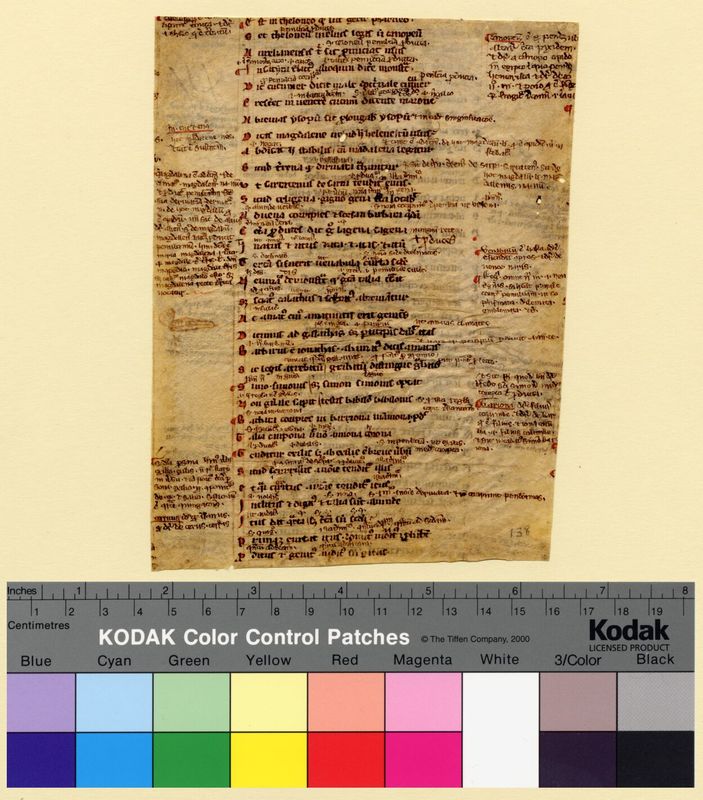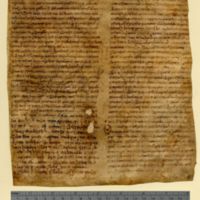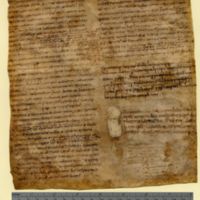Fragmenta Manuscripta
Grammar Instruction
Grammar Instruction
The study of grammar begins in Ancient Greece where students were taught the art of speaking and writing correctly. Grammar is studied alongside rhetoric, which supplied the formal rules for oral argument.[1] Fundamental to the study of grammar in medieval Europe were the works of Donatus (4th century) and Priscian (6th century), who took the Greek tradition and applied it to the Latin language.[2]
The first universities in Europe were founded by the end of the twelfth century and taught their courses in Latin. An important part of their curriculum was grammar along with rhetoric and logic. These three formed the trivium (meaning “a place where three roads meet"). The trivium was studied alongside the quadrivium (arithmetic, geometry, music, and astronomy), forming the seven liberal arts, a division credited to Cassiodorus (c. 487-583).
A Leaf with Several Grammatical Texts
Medieval scribes and authors would copy a manuscript word for word creating many copies of the same text. They would find authorities for certain topics and copy them into new works to form the canon of knowledge on a particular subject. This one leaf provides evidence for that very practice. The scribe copied the works of Bede, Priscian, Audax, and Jerome as authoritative authors on the study of grammar.
The leaf begins with the de Orthographia by Bede (672/3-735) on f.1r. Bede was an Anglo-Saxon theologian, historian, and chronologist from Jarrow, Northumbria. His best-known work is the Ecclesiastical History of the English People, which earned him the sobriquet “father of English history.” He was influenced by many Greek writers in de Orthographia including Diomedes, Caper, and Agroecius. The first part of the work contains what is known today as orthography—the conventions for spelling within a language. The rest of the work contains an alphabetical handbook of usage.[3]
The verso of the Fragmenta Manuscripta leaf contains an excerpt from Priscian (6th century). The text begins in the second column (column B) on the fourteenth line. This excerpt is from Institutio de nominee, pronomine et verbo or “On Noun, Prounoun, and Verb,” which was used in schools for teaching grammar. Priscian was one of the foundational figures for creating the study of grammar for the Latin language. Like Priscian’s other works, this text was heavily copied in the Middle Ages and later influenced the rise of speculative grammar or the logic of language in the thirteenth and fourteenth centuries.[4]
The manuscript leaf continues with three more passages on grammar. The first is by an unknown author. The second was written by a Latin grammarian named Audax (5th/6th century). The leaf concludes with a passage from Jerome (c. 347-419/420), who is best known for applying his studies on grammar and rhetoric to the translation of the Bible into Latin.

Identifier: Fragmenta Manuscripta 068
Date: 1290-1310
Contents: Doctrinale
Language: Latin
Location: England

Identifier: Fragmenta Manuscripta 138
Date: 1250-1299
Contents: Doctrinale with commentary
Language: Latin
Location: England
Doctrinale puerorum
The text on this manuscript leaf comes from Doctrinale puerorum (Teaching manual for Boys), written by Alexander of Villedieu (c. 1170-1240). Alexander studied in Paris, became a Franciscan, and a Master of the University of Paris. He was a grammarian, poet, and mathematician.[5] He wrote the Doctrinale around the year 1200 as a manual for instructing boys on the laws of grammar in 2645 lines. The text was divided into four parts. The declensions and conjugations constitute Part 1 (chapters 1-7); agreement and syntax form Part II (Chapters 8-9); prosody—which concerns intonation, tone, stress, and rhythm—is in Part III (Chapter 10); finally, Part IV (chapters 11-12) discusses placement, figures of speech, and faults of style.[6]
The Doctrinale became an important book for teaching Latin grammar at schools and universities. There are over 400 surviving manuscripts that contain the entire work or a portion of it.[7] The folia in the Fragmenta Manuscripta collection provides some evidence for the popularity of the text. FM 068 contains several lines (1668-1721) from Part III, Chapter 10 on prosody. The text of the Doctrinale is supplemented with a commentary on FM 138, showing that the text was so well-known that other people wrote additions to it.[8]
NOTES
[1] Peter Weeda, “Medieval Grammar and Rhetoric: Language Arts and Literary Theory, AD 300-1475 (Review),” Parergon 28 (2011): 182-184.
[2] “Grammar,” Encyclopedia Britannica, last modified, February 2020, https://www.britannica.com/topic/grammar.
[3] W.F. Bolton, History of Anglo-Latin Literature, 597-740 (Princeton: Princeton University Press, 1967); Martin Irvine, The Making of Textual Culture: “Gramatica” and Literary Theory 350-1100 (Cambridge: Cambridge University Press, 1994); “St. Bede the Venerable. Anglo-Saxon Historian,” Encyclopedia Britannica,last updated May 2020, https://www.britannica.com/biography/Saint-Bede-the-Venerable; for the text see Heinrich Keil, Grammatici latini, vol. 7, Scriptores de Orthographia (Leipzig: Teubner, 1880), 262-265.
[4] “Priscian, Latin Grammarian,” Encyclopedia Britannica, last updated June 2006, https://www.britannica.com/biography/Priscian; for the text see Heinrich Keil and Martin Hertz (eds.), Grammatici latini, vol. 3, Prisciani Institutionum Grammaticarum Libri 13-18, Prisciani Opera minora (Leipzig: Teubner, 1855).
[5] “Alexandre de Villedieu,” ARLIMA: archives de littérature du Moyen Âge, May 27, 2016, https://www.arlima.net/ad/alexandre_de_villedieu.html.
[6] “Alexander of Villedieu, Doctrinale puerorum (Teaching Manual for Children)," Les Enluminures, accessed August 24, 2020, https://www.textmanuscripts.com/tm-assets/tm-descriptions/descriptions-traces-apr/tm-871-doctrinale.pdf
[7] G.L. Bursill-Hall, “Teaching Grammars of the Middle Ages: Notes on the Manuscript Tradition,” Historiographica Linguistica 4 (1977): 1-6; “Alexander of Villedieu, Doctrinale puerorum."
[8] You can read the lines in Latin in this modern edition: Dietrich Reichling (ed.), Das Doctrinale des Alexander de Ville-Dei (Berlin: A. Hofmann & Comp., 1893).

